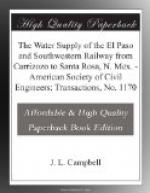On 8.6 miles, 11-in. pipe, 146,600 gal. per day = 17,046 gal. per mile. " 4 " 12 " " 14,829 " " " = 3,702 " " "
The 7-1/2-in. pipe on this section appears to be leaking less than the 12-in. pipe. Inspection and measurement of it are to be made in a short time.
There is no material leakage from the 10-and 16-in. pipe between Bonito Creek and Nogal Reservoir, as determined by velocity and volumetric measurements hereafter described. The greatest probable error in the velocity measurements would not exceed 1/2 per cent. If such error existed, and was all charged to leakage, it would amount to but 17,204 gal. per day, or 1,582 gal. per mile, out of a daily delivery of 3,784,000 gal.; but the measured discharge of the pipe, as determined by the velocity, was 5.84 sec-ft., while the mean maximum volume of this water over the weir at the end of the pipe is recorded by the weir as 5.88 sec-ft.
From Coyote, east along the railway, the wood pipe is remarkably tight. The rate of leakage from it, as determined by 600 observations uniformly distributed, was as follows:
11-in. pipe = 120 gal. per mile per day. 8-1/2 and 7-1/2-in. pipe = 268 " " " " "
The maximum rate on 1 mile was 1,613 gal. The minimum found was zero.
The observations were made by uncovering a joint and measuring the leakage therefrom for 10 min. A graduated glass measuring to drams was used. The rate of leakage varied from 5 drops to 45 oz. in 10 min. Of the joints uncovered 57% was found to be leaking. It is rather remarkable that, in the large leakage of the 11-and 12-in. pipe between Coyote and Bonito, only one out of every eight joints was leaking. This indicates a physical defect in such joints. The largest leak found on one joint was at the rate of 17[,?]280 gal. per day. Leakage between or through the staves is not measurable, as it is not fast enough to come away in drops unless there is some imperfection in the wood.
The insignificant leakage of 120 gal., stated above, is from the 11-in. pipe in the pumping main between Coyote and Corona. The present maximum working pressure on it is 100 lb. per sq. in. All the figures given above include visible and invisible leakage, the latter being such as does not appear on the surface. The visible leakage is but a small part of the total.
Stopping the Leaks.—Generally, any ordinary leak is readily stopped by pine wedges. Sometimes a loose joint requires individual bands bolted around it. Bran or saw-dust is effective in stopping the small leaks which cannot be reached by the wedges. The good effect of the latter is likely to be destroyed by a rapid emptying of the pipe. If the water is drawn out faster than the air can enter through the air-valves, heavy vacuums are formed down long slopes, and the air forces its way in through the joints and between the staves. The result is that the pipe will frequently leak badly for some time after it is refilled, although it may have been tight previously.




